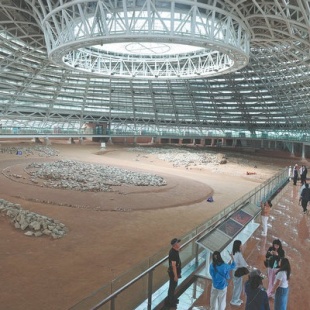Prehistoric echoes of our future
Global scholars explore how Chinese civilization's roots nourish profound modern vitality, report Fang Aiqing and Wu Yong in Chaoyang, Liaoning.

Guo Dashun, honorary director of the Liaoning Provincial Institute of Cultural Relics and Archaeology, points out: "Approaching Hongshan culture from a world history perspective provides a key to further in-depth research."
He notes that the Hongshan community, relying much on fishing and hunting, developed a reverence for nature. Maintaining mobility and openness, they were adept at identifying and assimilating advantageous elements from neighboring cultures to foster their own development.
According to Guo, one of the archaeologists who discovered the Niuheliang site in the early 1980s, Hongshan's painted pottery artifacts show influences from the Yangshao culture in the middle reaches of the Yellow River, as well as from civilizations in the central expanse of Eurasia, while the jade ware can be examined within the broader jade culture of eastern Asia.
At 87, Guo recently published The Ritual System Originated from the Hongshan: Discovery and Research of Niuheliang Site, in which he summarizes four decades of archaeological findings and discusses Hongshan's cultural legacies and far-reaching influences.
Zhao Hui, director of the provincial cultural heritage administration of Liaoning, says that the monograph aims to construct a comprehensive knowledge framework for the study of Hongshan, demonstrating how the West Liaohe River basin, alongside the Yellow and Yangtze river basins, serves as one birthplace of Chinese civilization.
Sun Jinsong, director of the Inner Mongolia Institute of Cultural Relics and Archaeology, introduced the excavations at the Yuanbaoshan archaeological site in Chifeng's Aohan Banner last year.
More than 100 jade relics have been unearthed from the site, dating back 5,000 to 5,400 years, including a palm-size, emerald green slit-ring shaped dragon — often called a "pig dragon" — which is considered one of the largest of its kind across Hongshan cultural sites. The "pig dragon" is recognized as a representative image of Hongshan.
Jade headgear suggests long-distance exchanges with the Lingjiatan culture in present-day Anhui province 5,800 to 5,300 years ago.
A circular rubble mound tomb with a diameter of 23.5 meters was discovered, accompanied by a square structure approximately 45 meters long to its south. Seven layers of stepped walls recede inward toward the center of the tomb, resembling a pyramid shape.
The architectural style, as well as the practice of laying jade artifacts inside and underneath the walls of the circular structure, are seen in the stonewalled settlements of Longshan culture in the middle and lower reaches of the Yellow River, such as the around 4,000-year-old Shimao site in Shenmu county, Northwest China's Shaanxi province.
Sun says that these findings testify to cross-regional interactions across China, demonstrating Hongshan culture's pivotal role in shaping Chinese civilization characterized by unity in diversity.





































